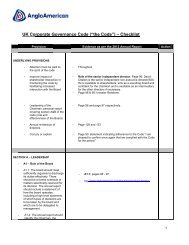- Page 1 and 2: A BALANCEDPORTFOLIOWITH THE FUTURE
- Page 4 and 5: HeadquartersLondon,United KingdomCo
- Page 6 and 7: OVERVIEW CHAIRMAN’S STATEMENTCHAI
- Page 8 and 9: OVERVIEW MARKETPLACEA BRIGHTER OUTL
- Page 10 and 11: OVERVIEW MARKETPLACEWELL PLACED FOR
- Page 12 and 13: OVERVIEW OUR STRATEGY AND BUSINESS
- Page 14 and 15: OVERVIEW CHIEF EXECUTIVE’S STATEM
- Page 16 and 17: OPERATING AND FINANCIAL REVIEW KEY
- Page 18 and 19: OPERATING AND FINANCIAL REVIEW STRA
- Page 20 and 21: OPERATING AND FINANCIAL REVIEW STRA
- Page 22 and 23: OPERATING AND FINANCIAL REVIEW STRA
- Page 24 and 25: OPERATING AND FINANCIAL REVIEW STRA
- Page 26 and 27: OPERATING AND FINANCIAL REVIEW STRA
- Page 28 and 29: OPERATING AND FINANCIAL REVIEW STRA
- Page 30 and 31: OPERATING AND FINANCIAL REVIEW STRA
- Page 32 and 33: OPERATING AND FINANCIAL REVIEW STRA
- Page 34 and 35: OPERATING AND FINANCIAL REVIEW STRA
- Page 36 and 37: OPERATING AND FINANCIAL REVIEW STRA
- Page 38 and 39: OPERATING AND FINANCIAL REVIEW STRA
- Page 40 and 41: OPERATING AND FINANCIAL REVIEW RESO
- Page 42 and 43: OPERATING AND FINANCIAL REVIEW RESO
- Page 46 and 47: OPERATING AND FINANCIAL REVIEW GROU
- Page 48 and 49: OPERATING AND FINANCIAL REVIEW GROU
- Page 50 and 51: OPERATING AND FINANCIAL REVIEW GROU
- Page 52 and 53: OPERATING AND FINANCIAL REVIEW RISK
- Page 54 and 55: OPERATING AND FINANCIAL REVIEW RISK
- Page 56 and 57: OPERATING AND FINANCIAL REVIEW RISK
- Page 58 and 59: OPERATING AND FINANCIAL REVIEW IRON
- Page 60 and 61: OPERATING AND FINANCIAL REVIEW IRON
- Page 62 and 63: OPERATING AND FINANCIAL REVIEW IRON
- Page 64 and 65: OPERATING AND FINANCIAL REVIEW META
- Page 66 and 67: OPERATING AND FINANCIAL REVIEW META
- Page 68 and 69: OPERATING AND FINANCIAL REVIEW THER
- Page 70 and 71: OPERATING AND FINANCIAL REVIEW THER
- Page 72 and 73: OPERATING AND FINANCIAL REVIEW COPP
- Page 74 and 75: OPERATING AND FINANCIAL REVIEW COPP
- Page 76 and 77: OPERATING AND FINANCIAL REVIEW NICK
- Page 78 and 79: OPERATING AND FINANCIAL REVIEW NICK
- Page 80 and 81: OPERATING AND FINANCIAL REVIEW PLAT
- Page 82 and 83: OPERATING AND FINANCIAL REVIEW PLAT
- Page 84 and 85: OPERATING AND FINANCIAL REVIEW PLAT
- Page 86 and 87: OPERATING AND FINANCIAL REVIEW DIAM
- Page 88 and 89: OPERATING AND FINANCIAL REVIEW DIAM
- Page 90 and 91: OPERATING AND FINANCIAL REVIEW OTHE
- Page 92 and 93: OPERATING AND FINANCIAL REVIEW OTHE
- Page 94 and 95:
GOVERNANCE INTRODUCTIONGOVERNANCESi
- Page 96 and 97:
GOVERNANCE THE BOARDTHE BOARDCHAIRM
- Page 98 and 99:
GOVERNANCE EXECUTIVE MANAGEMENTEXEC
- Page 100 and 101:
GOVERNANCE ROLE OF THE BOARDTHE ROL
- Page 102 and 103:
GOVERNANCE BOARD IN ACTIONBOARD VIS
- Page 104 and 105:
GOVERNANCE BOARD IN ACTIONBOARDCOMM
- Page 106 and 107:
GOVERNANCE BOARD IN ACTIONNOMINATIO
- Page 108 and 109:
GOVERNANCE AUDIT COMMITTEE REPORTAU
- Page 110 and 111:
GOVERNANCE AUDIT COMMITTEE REPORTOb
- Page 112 and 113:
GOVERNANCE DIRECTORS’ REMUNERATIO
- Page 114 and 115:
GOVERNANCE DIRECTORS’ REMUNERATIO
- Page 116 and 117:
GOVERNANCE DIRECTORS’ REMUNERATIO
- Page 118 and 119:
GOVERNANCE DIRECTORS’ REMUNERATIO
- Page 120 and 121:
GOVERNANCE DIRECTORS’ REMUNERATIO
- Page 122 and 123:
GOVERNANCE DIRECTORS’ REMUNERATIO
- Page 124 and 125:
GOVERNANCE DIRECTORS’ REMUNERATIO
- Page 126 and 127:
GOVERNANCE DIRECTORS’ REMUNERATIO
- Page 128 and 129:
GOVERNANCE DIRECTORS’ REMUNERATIO
- Page 130 and 131:
GOVERNANCE DIRECTORS’ REMUNERATIO
- Page 132 and 133:
GOVERNANCE DIRECTORS’ REPORTDIREC
- Page 134 and 135:
GOVERNANCE DIRECTORS’ REPORTEMPLO
- Page 136 and 137:
GOVERNANCE DIRECTORS’ REPORTIssue
- Page 138 and 139:
GOVERNANCE STATEMENT OF DIRECTORS
- Page 140 and 141:
FINANCIAL STATEMENTSRESPONSIBILITY
- Page 142 and 143:
FINANCIAL STATEMENTS PRINCIPAL STAT
- Page 144 and 145:
FINANCIAL STATEMENTS PRINCIPAL STAT
- Page 146 and 147:
FINANCIAL STATEMENTSNOTES TO THE FI
- Page 148 and 149:
FINANCIAL STATEMENTS NOTES TO THE F
- Page 150 and 151:
FINANCIAL STATEMENTS NOTES TO THE F
- Page 152 and 153:
FINANCIAL STATEMENTS NOTES TO THE F
- Page 154 and 155:
FINANCIAL STATEMENTS NOTES TO THE F
- Page 156 and 157:
FINANCIAL STATEMENTS NOTES TO THE F
- Page 158 and 159:
FINANCIAL STATEMENTS NOTES TO THE F
- Page 160 and 161:
FINANCIAL STATEMENTS NOTES TO THE F
- Page 162 and 163:
FINANCIAL STATEMENTS NOTES TO THE F
- Page 164 and 165:
FINANCIAL STATEMENTS NOTES TO THE F
- Page 166 and 167:
FINANCIAL STATEMENTS NOTES TO THE F
- Page 168 and 169:
FINANCIAL STATEMENTS NOTES TO THE F
- Page 170 and 171:
FINANCIAL STATEMENTS NOTES TO THE F
- Page 172 and 173:
FINANCIAL STATEMENTS NOTES TO THE F
- Page 174 and 175:
FINANCIAL STATEMENTS NOTES TO THE F
- Page 176 and 177:
FINANCIAL STATEMENTS NOTES TO THE F
- Page 178 and 179:
FINANCIAL STATEMENTS NOTES TO THE F
- Page 180 and 181:
FINANCIAL STATEMENTS NOTES TO THE F
- Page 182 and 183:
FINANCIAL STATEMENTS NOTES TO THE F
- Page 184 and 185:
FINANCIAL STATEMENTS NOTES TO THE F
- Page 186 and 187:
FINANCIAL STATEMENTS NOTES TO THE F
- Page 188 and 189:
FINANCIAL STATEMENTS NOTES TO THE F
- Page 190 and 191:
FINANCIAL STATEMENTS NOTES TO THE F
- Page 192 and 193:
FINANCIAL STATEMENTS NOTES TO THE F
- Page 194 and 195:
FINANCIAL STATEMENTS NOTES TO THE F
- Page 196 and 197:
ORE RESERVES AND MINERAL RESOURCESE
- Page 198 and 199:
ORE RESERVES AND MINERAL RESOURCESE
- Page 200 and 201:
ORE RESERVES AND MINERAL RESOURCESI
- Page 202 and 203:
ORE RESERVES AND MINERAL RESOURCESI
- Page 204 and 205:
ORE RESERVES AND MINERAL RESOURCESC
- Page 206 and 207:
ORE RESERVES AND MINERAL RESOURCESC
- Page 208 and 209:
ORE RESERVES AND MINERAL RESOURCESC
- Page 210 and 211:
ORE RESERVES AND MINERAL RESOURCESC
- Page 212 and 213:
ORE RESERVES AND MINERAL RESOURCESC
- Page 214 and 215:
ORE RESERVES AND MINERAL RESOURCESC
- Page 216 and 217:
ORE RESERVES AND MINERAL RESOURCESC
- Page 218 and 219:
ORE RESERVES AND MINERAL RESOURCESP
- Page 220 and 221:
ORE RESERVES AND MINERAL RESOURCESP
- Page 222 and 223:
ORE RESERVES AND MINERAL RESOURCESD
- Page 224 and 225:
ORE RESERVES AND MINERAL RESOURCESD
- Page 226 and 227:
ORE RESERVES AND MINERAL RESOURCESP
- Page 228 and 229:
ORE RESERVES AND MINERAL RESOURCESR
- Page 230 and 231:
ORE RESERVES AND MINERAL RESOURCESR
- Page 232 and 233:
ORE RESERVES AND MINERAL RESOURCESD
- Page 234 and 235:
ORE RESERVES AND MINERAL RESOURCESG
- Page 236 and 237:
OTHER INFORMATION PRODUCTION STATIS
- Page 238 and 239:
OTHER INFORMATION PRODUCTION STATIS
- Page 240 and 241:
OTHER INFORMATIONEXCHANGE RATES AND
- Page 242 and 243:
OTHER INFORMATIONKEY FINANCIAL DATA
- Page 244 and 245:
OTHER INFORMATIONRECONCILIATION OF
- Page 246 and 247:
OTHER INFORMATIONTHE BUSINESS - AN
- Page 248 and 249:
OTHER INFORMATIONSHAREHOLDER INFORM
- Page 250:
Anglo American plc20 Carlton House



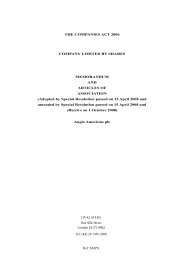
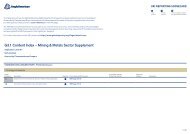

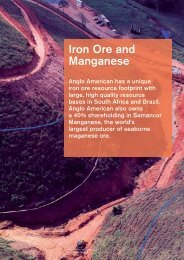
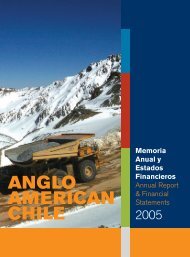
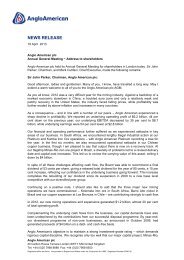
![English PDF [ 189KB ] - Anglo American](https://img.yumpu.com/50470814/1/184x260/english-pdf-189kb-anglo-american.jpg?quality=85)


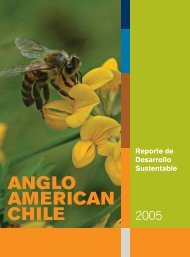
![pdf [ 595KB ] - Anglo American](https://img.yumpu.com/49420483/1/184x260/pdf-595kb-anglo-american.jpg?quality=85)
![pdf [ 1.1MB ] - Anglo American](https://img.yumpu.com/49057963/1/190x240/pdf-11mb-anglo-american.jpg?quality=85)
